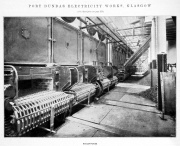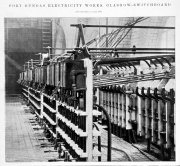Port Dundas Generating Station
1897 Two sites for new power stations, one for the north and another for the south side of the river, were purchased in Glasgow - about four and a half acres of ground at Port Dundas, adjoining the Forth and Clyde Canal at Speirs’ Wharf, and about two acres of ground close to Eglinton Toll, or St Andrew's Cross, in Pollokshaws Road.
c.1900 The station was built with engines and dynamos of both American and British manufacture, in various sizes from 200 h.p. to 2,400 h.p. each unit. The largest engines were built by Willans and Robinson, and the dynamos by the Westinghouse Co. The remaining engines were by the Ball and Wood Company, Messrs. Matthew Paul, Messrs. Mirrlees and Watson, Messrs. Belliss and Morcom, and Messrs. Willans and Robinson, and the dynamos by the Walker Co, the Schuckert Co, Crompton and Co, and the British Thomson-Houston Company. The condensing plant was all driven by electric motors, the air pumps being of Edwards’ patent design. The switchboards and recording gauges were constructed by Kelvin and James White, the Holland House Manufacturing Co, Messrs. Mechan and Sons, and Messrs. Laing, Wharton and Down.
1904 Large extensions were made at Port Dundas including installation of two steam turbines of 3,000 kW each from Willans and Robinson; three-phase alternators, working at 6,500 volts, 25 Hz, were constructed by Dick, Kerr and Co. The surface-condensing plant was immediately below them, so as to make the connections as short as possible, constructed by W. H. Allen, Son and Co, of Bedford. The switchboard for the control and measurement of high-tension currents was supplied by Messrs. Witting, Eborall and Co. The boilers for this extension were by Babcock and Wilcox, with a grate area of 100 square feet and a heating surface of 6,182 square feet each, the working steam pressure being 200 psi, each boiler being fitted with superheaters to give about 200 degrees of super heat.
See Also
Sources of Information
- Extracts from the 1904 Handbook on the Municipal Enterprises published by the Corporation of the City of Glasgow [1]




